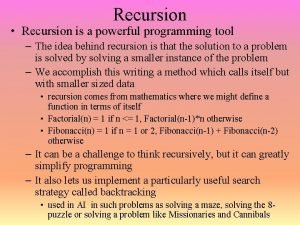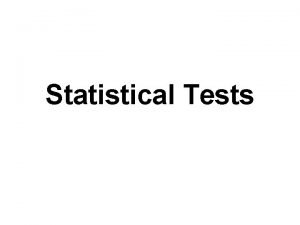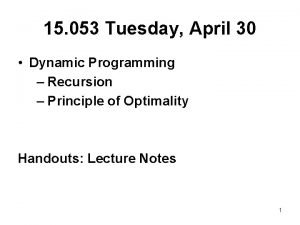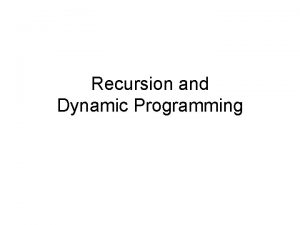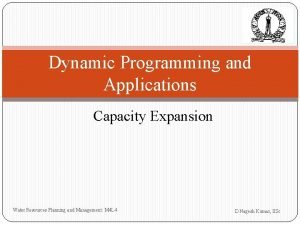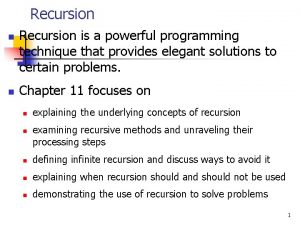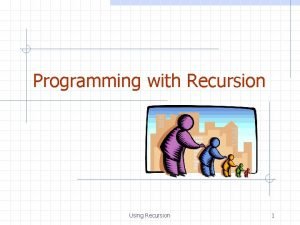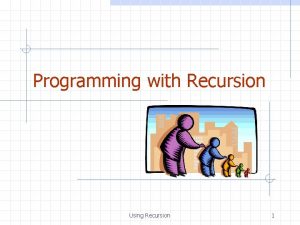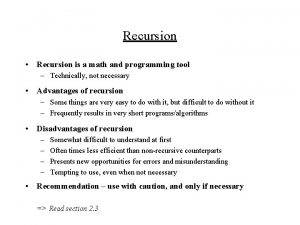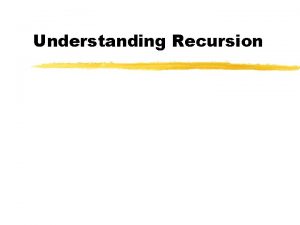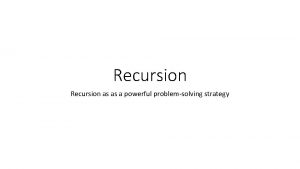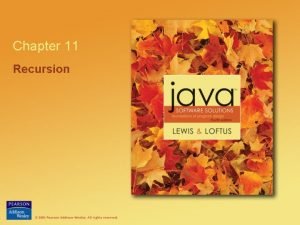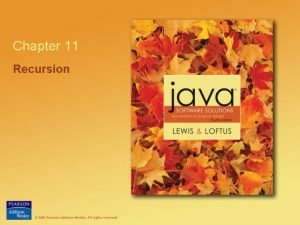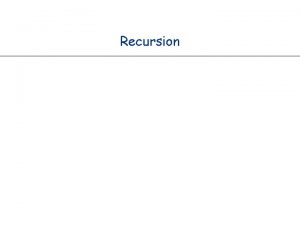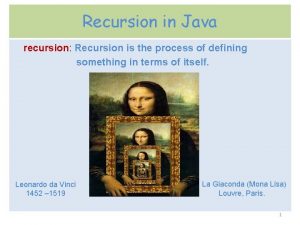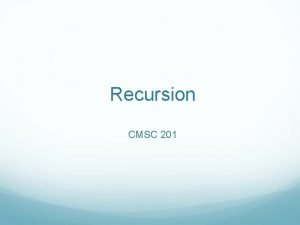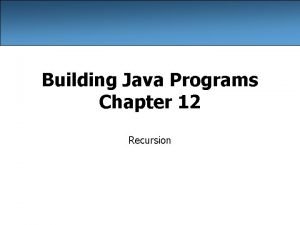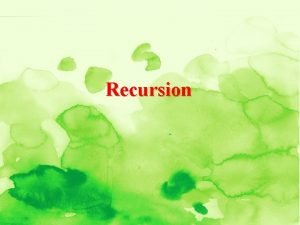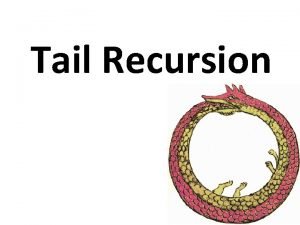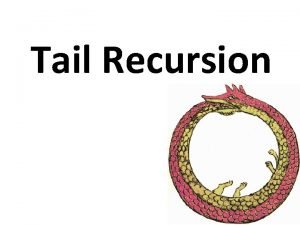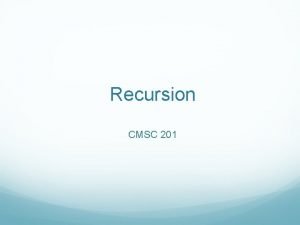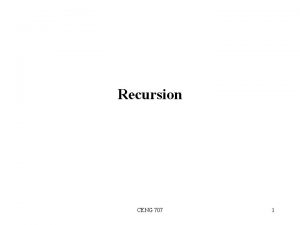Recursion Recursion is a powerful programming tool The









![public class Recursive. Backward { public static void main(String[] args) { String x="hello there"; public class Recursive. Backward { public static void main(String[] args) { String x="hello there";](https://slidetodoc.com/presentation_image_h/c25633d08f8daa348d2d8f44edd8f806/image-10.jpg)



![public class Goldbach { public static void main(String[] args) { int i; boolean temp=true; public class Goldbach { public static void main(String[] args) { int i; boolean temp=true;](https://slidetodoc.com/presentation_image_h/c25633d08f8daa348d2d8f44edd8f806/image-14.jpg)








![Solution public static boolean solve(int[][] m, int x, int y, int s) { if(x>=s||x<0||y>=s||y<0) Solution public static boolean solve(int[][] m, int x, int y, int s) { if(x>=s||x<0||y>=s||y<0)](https://slidetodoc.com/presentation_image_h/c25633d08f8daa348d2d8f44edd8f806/image-23.jpg)

![Recursive Sum of Subset public class Sum. Of. Subsets { public static void main(String[] Recursive Sum of Subset public class Sum. Of. Subsets { public static void main(String[]](https://slidetodoc.com/presentation_image_h/c25633d08f8daa348d2d8f44edd8f806/image-25.jpg)


![@Suppress. Warnings(“unchecked”) public static boolean solve(int[] set, int total, int i, int n, Array. @Suppress. Warnings(“unchecked”) public static boolean solve(int[] set, int total, int i, int n, Array.](https://slidetodoc.com/presentation_image_h/c25633d08f8daa348d2d8f44edd8f806/image-28.jpg)


















- Slides: 46

Recursion • Recursion is a powerful programming tool – The idea behind recursion is that the solution to a problem is solved by solving a smaller instance of the problem – We accomplish this writing a method which calls itself but with smaller sized data • recursion comes from mathematics where we might define a function in terms of itself • Factorial(n) = 1 if n <= 1, Factorial(n-1)*n otherwise • Fibonacci(n) = 1 if n = 1 or 2, Fibonacci(n-1) + Fibonacci(n-2) otherwise – It can be a challenge to think recursively, but it can greatly simplify programming – It also lets us implement a particularly useful search strategy called backtracking • used in AI in such problems as solving a maze, solving the 8 puzzle or solving a problem like Missionaries and Cannibals

Implementing Recursion • We will implement a recursive solution by having a method which calls itself with a smaller portion of the problem • We have to ensure though that at some point, we stop calling the method recursively or it could call itself forever – public void some. Method(int x) {some. Method(x -1); } • will recurse continually because there is nothing to stop it – public void some. Method(int x) {if(x>0) some. Method(x-1); } • this method instead stops once x is no longer positive • We will define a base case as the condition by which recursion stops • Our recursive method will return a value, perhaps an int which is the solution to the problem (e. g. , as in factorial), or in some cases, a boolean to indicate a solution was found

Example: Factorial • The common example is factorial – Factorial(5) = 5 * 4 * 3 * 2 * 1 (iterative) – Factorial(5) = 5 * Factorial(4) (recursive) – Factorial(4) = 4 * Factorial(3) (recursive) – Factorial(3) = 3 * Factorial(2) (recursive) – Factorial(2) = 2 * Factorial(1) (recursive) – Factorial(1) = 1 (recursive base case) public int iterative. Factorial(int x) { int product=1; for(int i=1; i<=x; i++) product=product*i; return product; } public int recursive. Factorial(int x) { if(x <= 1) return 1; else return x * recursive. Factorial(x-1); } Notice the recursive version has no local variables!

How Does Recursion Work?

How Does Recursion Work?

Example: Fibonacci Sequence • We start with two 1 s in the sequence – Each successive value is the sum of the previous two – Fib(n) = Fib(n-1) + Fib(n-2) if n > 2, 1 otherwise public int iterative. Fibonacci(int x) { int value 1=1, value 2=1, temp; for(int i=2; i<=x; i++) { temp=value 1; value 1=value 1+value 2; Again notice no local variables value 2=temp; in the recursive method } return value 1; } public int recursive. Fibonacci(int x) { { if(x<=2) return 1; else return recursive. Fibonacci(x-1) + recursive. Fibonacci(x-2); }

Drawbacks of Recursion • While some problems are hard to solve without recursion, not all problems should be solved with recursion if there are iterative solutions – The recursive solution can be a challenge to write and debug – The recursive solution uses more resources (each method call invokes the run-time stack for more storage space and to store the return location to the calling method) – The recursive version could be more computationally complex • Factorial: iterative solution has a loop that executes n times, recursive solution calls itself recursively n-1 times, approximately the same amount of work • Fibonacci: iterative solution has a loop that executes n-2 times, recursive version is trickier, see analysis on next slide – the key here is that Fibonacci calls itself twice for each recursive call

• • • Complexity of Recursive Fibonacci For n=1 or 2, do the base case For n=3, call Fib(2) and Fib(1) = 2 calls For n=4, call Fib(3) (2 calls) and Fib(2) (1 call) = 3 calls For n=5, call Fib(4) (3 calls) and Fib(3) (2 calls) = 5 calls For n=6, call Fib(5) (5 calls) and Fib(4) (3 calls) = 8 calls For n=7, call Fib(6) (8 calls) and Fib(5) (5 calls) = 13 calls For n=8, call Fib(7) (13 calls) and Fib(6) (8 calls) = 21 calls For n=9, call Fib(8) (21 calls) and Fib(7) (13 calls) = 34 calls In general, Fib(n) will require around 2 n calls, if n=20 this is about a million whereas the iterative version loops 18 times!

Thinking Recursively • It is a tremendous challenge to switch from iterative to recursive thinking • You have to think of the solution to a problem as being some steps & a call to the same method with a smaller portion of the problem • At some point, the smaller portion of the problem yields a direct answer, this is the base case • Test for the base case first in your code using an if, if-else or switch statement • If it is not the base case, then perform the recursion – To help you debug a recursive method, output the current values of any parameters and/or local variables to see where you are in the process – It is common to either have an incorrect base case or an incorrect recursive call that doesn’t reach the base case so that you have infinite recursion – after awhile, the JVM runs out of stack space and you get a Stack. Overflow. Error
![public class Recursive Backward public static void mainString args String xhello there public class Recursive. Backward { public static void main(String[] args) { String x="hello there";](https://slidetodoc.com/presentation_image_h/c25633d08f8daa348d2d8f44edd8f806/image-10.jpg)
public class Recursive. Backward { public static void main(String[] args) { String x="hello there"; A String and an int recurse(x); example of using recursion System. out. println(); int y=12345; System. out. println(recurse(y, 1)+ “n”); } public static void recurse(String x) { if(x. length()>0) { System. out. print(x. char. At(x. length()-1)); recurse(x. substring(0, x. length()-1)); } } public static int recurse(int x, int n) { if(n==0) return x; else { int temp=(int)Math. pow(10, n); int temp 2=x/temp; return temp 2 + 10*recurse(x-temp 2*temp, n-1); } } }

public static boolean is. Palindrome(String x) { if(x. length()==0||x. length()==1) return true; else if(x. char. At(0)!=x. char. At(x. length()-1)) return false; else return is. Palindrome(x. substring(1, x. length()-1)); } public static int find(int[] array, int l, int h, int t) { if(l>h) return -1; else { int mid=(l+h)/2; if(array[mid]==t) return mid; else if(array[mid]>t) return find(array, l, mid-1, t); else return find(array, mid+1, h, t); } } public static void sort(int[] list, int low, int high) { if(low < high) { int index=low, min=list[low]; for(int i=low+1; i<=high; i++) { if(list[i]<min) {min=list[i]; index=i; }} list[index]=list[low]; list[low]=min; sort(list, low+1, high); }

Recursively Computing Directory Size import java. io. *; import java. util. *; public class Directory. Size { public static void main(String[] args) { System. out. print("Enter directory name: "); Scanner input=new Scanner(System. in); String dir=input. next. Line(); System. out. println(get. Size(new File(dir)) + " bytes"); } public static int get. Size(File f) { int size=0; if(f. is. Directory()){ File[] files=f. list. Files(); for(int i=0; files!=null&&i<files. length; i++) size+=get. Size(files[i]); } else size+=f. length(); return size; } }

Goldbach Numbers • In 1742, German mathematician Christian Goldbach submitted the conjecture that all prime numbers greater than 2 can be expressed as the sum of 2 prime numbers – This is a conjecture because there is no proof for this but we can test it out to some large number • We will solve this problem using recursion – We will use two recursive methods • find(x, y) – locate two even int values x and y both of which are prime, we will call this method with 3 and i-3 where i is a loop index to test the conjecture by iterating from 4 to some very large number • is. Prime(x) – determine if x is prime or not
![public class Goldbach public static void mainString args int i boolean temptrue public class Goldbach { public static void main(String[] args) { int i; boolean temp=true;](https://slidetodoc.com/presentation_image_h/c25633d08f8daa348d2d8f44edd8f806/image-14.jpg)
public class Goldbach { public static void main(String[] args) { int i; boolean temp=true; for(i=6; i<10000; i+=2) { temp=find(3, i-3); if(!temp) System. out. println(i + " is not a Goldblatt number"); } } public static boolean find(int x, int y) { if(x>y) return false; else if(isprime(x, 2)&&isprime(y, 2)) { System. out. println((x+y) + " = " + x + " + y); return true; } else return find(x+2, y-2); } public static boolean isprime(int x, int y) { if(y>x/2) return true; else if(x%y==0) return false; else return isprime(x, y+1); } }

Other String Recursive Methods • Compute the length of a String – if string is “” then return 0, otherwise add 1 to the recursive call passing the rest of the String public static int recursive. Length(String a) { if(a. equals("")) return 0; else return 1+recursive. Length(a. substring(1)); } • Merge 2 Strings together, character by character, until we reach the end of one String, then append the other String public static String combine(String a, String b) { if(a. equals("")) return b; else if(b. equals("")) return a; else return ""+a. char. At(0)+b. char. At(0)+ combine(a. substring(1), b. substring(1)); }

Recursive String Compare • A recursive compare will have 4 base cases: – End of both Strings, return 0 – End of one String, the other String is greater – Mismatch in the 0 th character, return their difference – Otherwise, return the value obtained by recursively calling compare with the remainder of both Strings public static int recursive. Compare(String a, String b) { if(a. equals("")&&b. equals("")) return 0; else if(a. equals("")) return (int)b. char. At(0); else if(b. equals("")) return (int)a. char. At(0); else if(a. char. At(0)==b. char. At(0)) return recursive. Compare(a. substring(1, a. length()), b. substring(1, b. length())); else return (int)a. char. At(0)-(int)b. char. At(0); }

Towers of Hanoi • The problem is based on a story from an Indian temple – There are 3 poles and 64 golden disks of different sizes, currently they reside on one pole, oriented from largest (bottom) to smallest (top) – Moving 1 disk at a time, move all of the disks to the third pole in such a way that no larger disk is ever on top of a smaller disk • use the middle pole as an intermediary position to place disks as needed • How do you solve this problem? How much time will it take? • The problem was later posed by French mathematician Edouard Lucas in 1883 – Today, we view the problem as having fewer disks (usually 3 or 7) – We will solve this problem recursively

We solve the problem with 2 disks and move the large disk to its destination and then solve the problem with 2 disks again

Recursive Solution • Move the first n-1 disks from pole A to B • Move disk n from pole A to C • Move the first n-1 disks from pole B to C • To solve the first n-1 disks – Move the first n-2 disks from pole A to C – Move disk n-1 from pole A to B – Move the first n-2 disks from pole C to B • To solve the first n-2 disks – Move the first n-3 disks from pole A to B – Move disk n-2 from pole A to C – Move the first n-2 disks from pole B to C

Solution public static void hanoi(int n, int a, int b, int c) { if(n==1) System. out. println("Move disk 1 from " + a + " to " + c); else { hanoi(n-1, a, c, b); System. out. println("Move disk " + n + " from " + a + " to " + c); hanoi(n-1, b, a, c); } • We would call hanoi passing it n (number of disks) and the int values 1, 2, 3 – Notice how each recursive call to hanoi exchanges the poles • Also notice how this recursive solution has 2 method calls per recursive call – remember how Fibonacci resulted in a very large number of invocations recursively? What about Hanoi?

Hanoi’s Complexity • If n = 1 (base case) 1 movement (20) • If n = 2 call Hanoi(1) + 1 movement + Hanoi(1) = 1 +1=3 • If n = 3 call Hanoi(2) + 1 movement + Hanoi(2) = 3 + 1 +3=7 • If n = 4 call Hanoi(3) + 1 movement + Hanoi(3) = 7 + 1 + 7 = 15 • If n = 5 call Hanoi(4) + 1 movement + Hanoi(4) = 15 + 15 = 31 – notice a trend? with each larger integer, we double the number of the previous size + 1, that is, Hanoi(n-1) + 1 + Hanoi(n-1), this gives us a “recurrence relation” of 2 n - 1 – for n = 8, it takes 255 movements – for n = 20, it takes more than 1 million moves – for n = 30, it takes more than 1 billion moves – what about for 64? Try 18, 446, 744, 073, 709, 551, 615

Solving a Maze • We represent our maze as a 2 D array of int values – 0 – wall – 1 – path – 2 – exit int[][] maze={ {0, 0, 0, 1, 0, 0, 0, 0, 0}, {0, 1, 0, 0, 1, 1, 0, 0, 0, 1, 1, 0, 0, 0}, {0, 1, 0, 0, 1, 1, 1, 0, 0, 0}, {0, 1, 1, 0, 0, 0, 1, 1, 0, 0, 0, 1, 0, 0, 0}, {0, 0, 1, 1, 0, 0, 0, 1, 1, 1, 0, 0}, {0, 0, 1, 1, 0, 1, 0, 0, 1, 1, 0, 0}, {0, 0, 1, 0, 0, 0, 1, 0, 0, 1, 0, 0}, {0, 1, 1, 0, 0, 0, 1, 0, 0, 1, 1, 1, 0, 0, 0}, {0, 1, 0, 0, 0, 1, 1, 1, 0, 0, 1, 1, 1, 0}, {0, 1, 1, 0, 0, 0, 0, 0, 1, 0}, Use a boolean function which {0, 0, 1, 1, 0, 0, 0, 0, 1, 1, 1, 0}, {0, 0, 0, 1, 1, 0, 0, 1, 1, 1, 0, 0, 0}, returns false if current path {0, 1, 1, 0, 0, 0, 1, 1, 1, 0, 0}, either {0, 0, 1, 0, 0, 0, 1, 0, 0}, {0, 0, 1, 1, 0, 0, 0, 1, 1, 1, 0, 1, 1, 0}, is a deadend (hits a wall) {0, 0, 1, 1, 1, 0, 0, 0, 1, 0, 0, 1, 0}, or has been checked before {0, 0, 1, 1, 0, 0, 0, 1, 1, 0}, {0, 0, 0, 1, 1, 0, 0, 0, 0}, returns true if solution (2) {0, 0, 0, 1, 1, 1, 0, 0, 0, 0}, Otherwise, recursively tests {0, 1, 1, 1, 0, 0, 0, 1, 1, 1, 0, 0}, {0, 1, 0, 0, 0, 1, 1, 1, 0, 0, 0}, each of the 4 directions, marking the current location {0, 1, 0, 0, 0, 1, 1, 0, 0, 0}, {0, 1, 1, 1, 0, 0, 0, 1, 1, 0, 0}, as “tried” to avoid repeated {0, 0, 1, 0, 0, 0, 1, 1, 2, 0, 0}}; • size=24 • x=0, y=5 trying the same path
![Solution public static boolean solveint m int x int y int s ifxsx0ysy0 Solution public static boolean solve(int[][] m, int x, int y, int s) { if(x>=s||x<0||y>=s||y<0)](https://slidetodoc.com/presentation_image_h/c25633d08f8daa348d2d8f44edd8f806/image-23.jpg)
Solution public static boolean solve(int[][] m, int x, int y, int s) { if(x>=s||x<0||y>=s||y<0) return false; Out of bounds? Path tried? else if(m[x][y]==3) return false; Solution? else if(m[x][y]==2) return true; else if(m[x][y]==0) return false; Wall? else { Otherwise, mark m[x][y]=3; if (solve(m, x+1, y, s)) return true; This cell as “tried” if (solve(m, x-1, y, s)) return true; And now recursive if (solve(m, x, y+1, s)) return true; Try all 4 directions if (solve(m, x, y-1, s)) return true; m[x][y]=1; If none lead to return false; a solution, this is } a deadend, reset } If successful, solve returns true. In main, we can print the maze where we will see the number 3 indicates the correct path to take to get out of the maze path to untried and return false – couldn’t find a solution

Sum of Subset • One of the cornerstones of our modern world is encryption used to allow secure telecommunications – We use a numeric key (a set of numbers) – A message is converted into binary and each 1 is exchanged with the integer number from the corresponding location in the key – We sum this up and transmit this • If someone intercepts this sum, it is challenging to decrypt it because we have to determine the proper subset of the set that makes up this sum, thus “sum of subset” – A decryption key is available that can easily compute the sum of subset because the decryption key has a property known as increasingly additive – For instance, {16, 33, 12, 8, 20, 7, 18, 9, 15, 10} is not increasing additive while {1, 3, 6, 11, 23, 45, 100, 192, 505, 2221} is
![Recursive Sum of Subset public class Sum Of Subsets public static void mainString Recursive Sum of Subset public class Sum. Of. Subsets { public static void main(String[]](https://slidetodoc.com/presentation_image_h/c25633d08f8daa348d2d8f44edd8f806/image-25.jpg)
Recursive Sum of Subset public class Sum. Of. Subsets { public static void main(String[] args) { int sum=97, n=10; int[] set={16, 33, 12, 8, 20, 7, 18, 9, 15, 10}; System. out. println(find(sum, set, n-1)); } public static boolean find(int sum. Left, int[] set, int n) { if(sum. Left==0) return true; else if(n<0) return false; return find(sum. Left, set, n-1)||find(sum. Left-set[n], set, n-1); } } • This works by testing for each recursive call two recursive calls checking if the item at n-1 should or should not be in the subset • But notice that while this solution tells us if there is a solution, it does not provide the solution for us! • One challenge with recursive solutions is also returning the solution

How Do We Store the Solution? • Let’s add an Array. List variable to our class as an instance variable – This makes it available in both main and find – Now we have to decide whether to add the current set[n] that we are looking at into the Array. List or not – We change find as follows public static boolean find(int sum. Left, int[] set, int n) { if(n<0) return false; else if(sum. Left==0) return true; boolean temp 1=find(sum. Left, set, n-1); boolean temp 2=find(sum. Left-set[n], set, n-1); if(temp 2) list. add(set[n]); return temp 1||temp 2; } list will wind up storing: [33, 12, 8, 20, 9, 15, 33, 12, 8, 33, 20, 7, 18, 9, 33, 12, 20, 7, 33, 12, 18, 9, 15, 10]

What Happened? • You might notice that our solution, list, does include a solution to the problem – in fact it contains several solutions – [33, 12, 8, 20, 9, 15, 33, 12, 8, 33, 20, 7, 18, 9, 33, 12, 20, 7, 33, 12, 18, 9, 15, 10] • 33 + 12 + 8 + 20 + 9 + 15 = 97 • 33 + 12 + 18 + 9 + 15 + 10 = 97 • The problem is that as we recurse twice per method call, we might find solutions down either or both branches of our search space – If we find a solution down both branches, we will have added set[n] into list along different paths and this will result in having multiple solutions combined into list • We can resolve this problem in several ways, we look at one approach
![Suppress Warningsunchecked public static boolean solveint set int total int i int n Array @Suppress. Warnings(“unchecked”) public static boolean solve(int[] set, int total, int i, int n, Array.](https://slidetodoc.com/presentation_image_h/c25633d08f8daa348d2d8f44edd8f806/image-28.jpg)
@Suppress. Warnings(“unchecked”) public static boolean solve(int[] set, int total, int i, int n, Array. List temp. List) { if(total<0) return false; else if(total==0) { This compiler directive list. add(0); Is required because of list. add. All(temp. List); oddities with Array. List return true; } else if(i>=n) return false; else { temp. List. add(set[i]); boolean temp 1=solve(set, total-set[i], i+1, n, temp. List); if(temp. List. contains(new Integer(set[i]))) temp. List. remove(new Integer(set[i])); boolean temp 2=solve(set, total, i+1, n, list); if(temp 1||temp 2) return true; else return false; } } We add another Array. List, temp. List, which is passed as a parameter to solve This Array. List is used to store the current solution we are working on, if we find a solution, add a 0 to list and then add temp. List to list If this pathway has not led to a solution, we remove set[i] from temp. List

Recursion as Search • The sum of subsets problem and the maze problem are both examples of search problems – Given all the possibilities, search for the solution – Usually search problems have a 2 n complexity (like Hanoi) – Additionally, to solve the problem, we need to be able to backtrack when our search either leads us to a repeated state or a deadend • e. g. , a wall in the maze or a sum > the target sum in the subset problem – Recursion is helpful here because, if we reach a deadend, we return and try the next branch • look at the maze solution which tries one path and if not successful, tries the next, etc

Backtracking • Consider this code: – – if if (solve(m, x+1, y, s)) (solve(m, x-1, y, s)) (solve(m, x, y+1, s)) (solve(m, x, y-1, s)) return true; • Because of the recursive nature of the code, we try one move (say x+1, y) and if that leads us to a solution, this call to solve(m, x+1, y, s) returns true so we return true • But if not, we are back where we were in this method call (x, y) and we try the next branch (x-1, y) – Thus, when we return from a recursive call, we either receive true and return true meaning “solution found” or we receive false and we try the next branch • The idea that recursion automatically returns us to where we were is called backtracking – Without recursion, I have to implement backtracking through a stack

Water Jugs Problem • Another well known AI search problem is the water jugs – The idea is to find the proper combination of steps using 2 jugs, 1 can hold 4 gallons, 1 can hold 3 gallons, to wind up with exactly 2 gallons in the 4 gallon jug – You do this by pouring water into and out of jugs – You can not “estimate”, you have to be exact which you can get by pouring from one to the other in different ways • for instance, if you have 4 and 0, you can pour 3 gallons exactly from the 4 -gallon to the 3 -gallon jug and wind up with 1 and 3 • Search problems are best solved recursively

Recursive Solution • We will have a boolean method jugs(int x, int y) – Base cases: • if x==2 then solution found, return true • if x < 0 || x > 4 || y < 0 || y > 0 then illegal state, return false – Otherwise try each of the possible recursive cases • • • Fill 4 gallon jug – from (x, y) to (4, y) Fill 3 gallon jug – from (x, y) to (x, 3) Dump 4 gallon jug – from (x, y) to (0, y) Dump 3 gallon jug – from (x, y) to (x, 0) Pour contents of 4 gallon jug to 3 gallon jug until 3 gallon jug is full – from (x, y) to (x – (3 – y), 3) • Pour contents of 3 gallon jug to 4 gallon jug until 4 gallon jug is full – from (x, y) to (4, y – (4 – x)) • Empty 4 gallon jug into 3 gallon jug – from (x, y) to (0, x + y) • Empty 3 gallon jug into 4 gallon jug – from (x, y) to (x + y, 0)

• Start at (0, 0) – – – A Solution Fill 3 gallon jug (0, 3) Pour contents of 3 gallon jug to 4 gallon jug (3, 0) Fill 3 gallon jug (3, 3) Pour contents of 3 gallon jug to 4 gallon jug (4, 2) Empty 4 gallon jug (0, 2) Pour contents of 3 gallon jug to 4 gallon jug (2, 0) • note there are other solutions • Problem: – – What if we attempt a state we have already visited? For instance: (0, 0) (4, 0) (0, 0) We have to avoid repeated states We add to our recursive solution an instance datum that will record every state we have visited – Upon recursive call, if (x, y) is already in this list, return false

import java. util. *; public class Waterjugs { private static Array. List<String> tried; public static void main(String[] args) { tried=new Array. List<>(); System. out. println(jugs(0, 0)); } public static boolean jugs(int x, int y) { boolean temp; if(tried. contains(""+x+y)) return false; else tried. add(""+x+y); if(x<0||x>4||y<0||y>3) return false; else if(x==2) return true; else { temp=jugs(x, 0); if(!temp) temp=jugs(0, y); if(!temp) temp=jugs(4, y); if(!temp) temp=jugs(x, 3); if(!temp) temp=jugs(x+y, 0); if(!temp) temp=jugs(0, x+y); if(!temp) temp=jugs(x-(3 -y), 3); if(!temp) temp=jugs(4, y-(4 -x)); } return temp; Add this instruction to see the correct steps: } if(temp) System. out. println(""+x+" "+y); }

Other Search Problems • AI is full of search problems – Missionaries and Cannibals • there are 3 Missionaries and 3 Cannibals on the left bank of a river • there is a canoe in which up to 2 people can sit • what combination of moves should be made to move all 6 across the river to the right side such that we never have more Cannibals than Missionaries on either side of the river (otherwise, the Cannibals will eat the Missionaries!) – Solution • use a recursive method which receives a 5 -tuple (a, b, c, d, e) where a/b = M and C on left side, c/d = M and C on right, e = position of boat (0 = left, 1 = right) • requires maintaining a list of states already visited so that you don’t have infinite recursion • requires a mechanism to output the solution, if found

Other Search Problems • Knapsack – Given a set of objects, each with its own weight and value and a knapsack that can store a certain weight – Find the subset of objects that fit within the knapsack (that is, whose total weight <= capacity of the knapsack) that maximizes the worth • Given two arrays – – values={10, 15, 8, 12, 21, 13, 14, 9, 16, 6} weights={5, 8, 3, 6, 7, 12, 9, 10, 7, 10, 4} and capacity=25 find a boolean array knapsack where knapsack[i] = true if item i should be placed in the knapsack and false otherwise • This is similar to the sum of subsets problem in that we want to find a subset of weights whose sum <= capacity, but in this case we want to maximize the corresponding values

Other Search Problems • 8 Puzzle – Carnival toy of 8 sliding digits and 1 blank – slide the digits to form a pattern like 123/456/78_ – Recursive solution – similar to the maze problem – Need to keep track of states visited to not return to one • Unlike maze, water jugs, M/C, this problem’s solution can be improved by the use of a heuristic – When faced with a choice of which move to make, use a heuristic function to compute the move that is most likely to take you to the solution – Otherwise, there a lot of states you might try • 8!/2 = 20160 states you might have to search through! – With a good heuristic, you might reduce this to a few hundred or less • Related problem: solving a rubic’s cube

Other Search Problems • 8 Queens – Position 8 queens on a chessboard such that no queen capture another • Knight’s Tour – What moves does a knight have to make when positioned on an empty chessboard to touch every square without repeating any square? • Traveling Salesman problem – Given a set of cities with a cost associated with traveling between any two cities, find the path that takes a person from a start city to every other city and back that is the least costing path (note: not all cities may have a path) • Games like checkers, chess, tic-tac-toe • We study search problems in AI and we study other recursive problems in 464 along with another form of problem solving called Dynamic Programming that might reduce the complexity of the search

Recursive Graphics • Fractal images are generated recursively – Since they are created by a mathematical equation, we can zoom in on any part and never “lose focus” (that is, the image never blurs) – Rather than seeing a true fractal design, we will do a couple of simplistic designs • Recursive I – Draw an I and then for each end of the line recursively draw Is • 3 -line design – From our starting point, draw 3 lines (one up, one at each of 45 and -45 degrees from the starting point) and recursively do the same • note that in both cases, we will eventually reach a point where the sizes used for the endpoints of our lines are equal, this will be our base case to stop recursing (no point in further recursion as we can’t draw any smaller pixels)

Drawing Recursive Is • Given two points, x 1, y 1 and x 2, y 2, we want to draw a line between them and then recursively add 2 lines at the end points – We need to alternate drawing horizontal and vertical lines • we do this by setting x 1=x 2 or y 1=y 2 – We also have a special case for our first output in that we will just draw a single top-down line • We will use three conditions – If c==0 then draw a single line and recurse with c=1 – If x 1==x 2 && y 1==y 2 stop recursing – Otherwise if c is even, draw a horizontal line and recurse twice with c+1 and the same y values and if c is odd, draw a vertical line and recurse twice with c+1 and the same x values

public static class Draw. Panel extends Jpanel { public void paint. Component(Graphics g) { int x 1=300, y 1=200, x 2=300, y 2=500; create(g, x 1, y 1, x 2, y 2, 0, 300); } public void create(Graphics g, int x 1, int y 1, int x 2, int y 2, int c, int size) { if(c==0) { g. draw. Line(x 1, y 1, x 2, y 2); create(g, x 1 -size/2, y 1, x 2+size/2, y 1, c+1, size/2); create(g, x 1 -size/2, y 2, x 2+size/2, y 2, c+1, size/2); } else if(x 1!=x 2||y 1!=y 2) { if(c%2==0) { g. draw. Line(x 1, y 1, x 2, y 2); create(g, x 1 -size/2, y 1, x 1+size/2, y 1, c+1, size/2); create(g, x 2 -size/2, y 2, x 2+size/2, y 2, c+1, size/2); } else { g. draw. Line(x 1, y 1, x 2, y 2); create(g, x 1, y 1 -size/2, x 1, y 1+size/2, c+1, size/2); create(g, x 2, y 1 -size/2, x 2, y 1+size/2, c+1, size/2); } }

public static class Draw. Panel extends JPanel { public void paint. Component(Graphics g) { draw(g, 350, 300, 250, 0); } public void draw(Graphics g, int x, int y, int size, int c) { if(c<8) { g. draw. Line(x-size/4, y-size/4, x, y); g. draw. Line(x, y-size/2, x, y); g. draw. Line(x+size/4, y-size/4, x, y); draw(g, x-size/4, y-size/4, size/2, c+1); draw(g, x+size/4, y-size/4, size/2, c+1); draw(g, x, y-size/2, c+1); } } }


public static class GP extends JPanel { public void paint. Component(Graphics g) draw(g, 250, 100, 400, 6); } Sierpinski Triangles public void draw(Graphics g, int x 1, int y 1, int x 2, int y 2, int x 3, int y 3, int n) { if(n>0){ g. draw. Line(x 1, y 1, x 2, y 2); g. draw. Line(x 2, y 2, x 3, y 3); g. draw. Line(x 3, y 3, x 1, y 1); draw(g, x 1, y 1, (x 1+x 2)/2, (y 1+y 2)/2, (x 1+x 3)/2, (y 1+y 3)/2, n-1); draw(g, (x 1+x 2)/2, (y 1+y 2)/2, x 2, y 2, (x 2+x 3)/2, (y 2+y 3)/2, n-1); draw(g, (x 1+x 3)/2, (y 1+y 3)/2, (x 2+x 3)/2, (y 2+y 3)/2, x 3, y 3, n-1); } }

Recursion vs Iteration • Any problems solvable by recursion can be solved by iteration – It may require the implementation of a stack to handle a data access • the stack provides us with a Last In First Out (LIFO, or FILO) access – we look at stacks later in the semester – And in some cases, we can implement an iterative implementation without a stack such as factorial, Fibonacci, or printing lists backward – Recursion can simplify problem solving if you see the solution but it also incurs a large overhead in method calls and returns, all using stack space (we also have to worry about running out of stack space) • In general, solve a problem iterative if there is an easy iterative solution – Otherwise, if there is an easy recursive solution, use it – Otherwise there is no easy solution, use whichever approach gives you a solution that you can implement

Tail Recursion • When implementing a problem recursively, we may have a choice as to in our recursive method – perform recursion and then use the return value to compute something to return – compute something and add it to the result of our recursive call • If, upon returning from a recursive call, there is nothing else to do, this is known as tail recursion – Our solutions to factorial, Recursive. Backward (printing Strings and ints backward), is. Palindrome, binary search and selection sort were all tail recursive – Our solutions to Fibonacci, Hanoi, Directory. Size, Maze and the Graphics examples were not because each recursive call possibly required 2 or more recursive calls • The reason this is important is that an optimizing compiler can reduce the size of stack space usage in some cases with tail recursion
 What is recursion can be a powerful tool for solving?
What is recursion can be a powerful tool for solving? To understand recursion you must understand recursion
To understand recursion you must understand recursion A powerful tool in statistics
A powerful tool in statistics A powerful tool in statistics
A powerful tool in statistics Dynamic programming recursion example
Dynamic programming recursion example Recursive thinking definition
Recursive thinking definition Dynamic programming recursion example
Dynamic programming recursion example Runtime programming
Runtime programming Linear vs integer programming
Linear vs integer programming Perbedaan linear programming dan integer programming
Perbedaan linear programming dan integer programming Definisi integer
Definisi integer Greedy vs dynamic
Greedy vs dynamic Potter's tool is data cleaning tool
Potter's tool is data cleaning tool Voi kéo gỗ như thế nào
Voi kéo gỗ như thế nào Thiếu nhi thế giới liên hoan
Thiếu nhi thế giới liên hoan Tia chieu sa te
Tia chieu sa te Một số thể thơ truyền thống
Một số thể thơ truyền thống Các châu lục và đại dương trên thế giới
Các châu lục và đại dương trên thế giới Thế nào là hệ số cao nhất
Thế nào là hệ số cao nhất Hệ hô hấp
Hệ hô hấp Các số nguyên tố
Các số nguyên tố Tư thế ngồi viết
Tư thế ngồi viết Hình ảnh bộ gõ cơ thể búng tay
Hình ảnh bộ gõ cơ thể búng tay đặc điểm cơ thể của người tối cổ
đặc điểm cơ thể của người tối cổ Mật thư anh em như thể tay chân
Mật thư anh em như thể tay chân Tư thế worm breton
Tư thế worm breton ưu thế lai là gì
ưu thế lai là gì Thẻ vin
Thẻ vin Thể thơ truyền thống
Thể thơ truyền thống Cái miệng bé xinh thế chỉ nói điều hay thôi
Cái miệng bé xinh thế chỉ nói điều hay thôi Các châu lục và đại dương trên thế giới
Các châu lục và đại dương trên thế giới Bổ thể
Bổ thể Từ ngữ thể hiện lòng nhân hậu
Từ ngữ thể hiện lòng nhân hậu Tư thế ngồi viết
Tư thế ngồi viết Diễn thế sinh thái là
Diễn thế sinh thái là Frameset trong html5
Frameset trong html5 V cc cc
V cc cc Phép trừ bù
Phép trừ bù Chúa yêu trần thế
Chúa yêu trần thế Khi nào hổ mẹ dạy hổ con săn mồi
Khi nào hổ mẹ dạy hổ con săn mồi đại từ thay thế
đại từ thay thế Vẽ hình chiếu vuông góc của vật thể sau
Vẽ hình chiếu vuông góc của vật thể sau Công của trọng lực
Công của trọng lực Tỉ lệ cơ thể trẻ em
Tỉ lệ cơ thể trẻ em Thế nào là mạng điện lắp đặt kiểu nổi
Thế nào là mạng điện lắp đặt kiểu nổi Các loại đột biến cấu trúc nhiễm sắc thể
Các loại đột biến cấu trúc nhiễm sắc thể Lời thề hippocrates
Lời thề hippocrates
